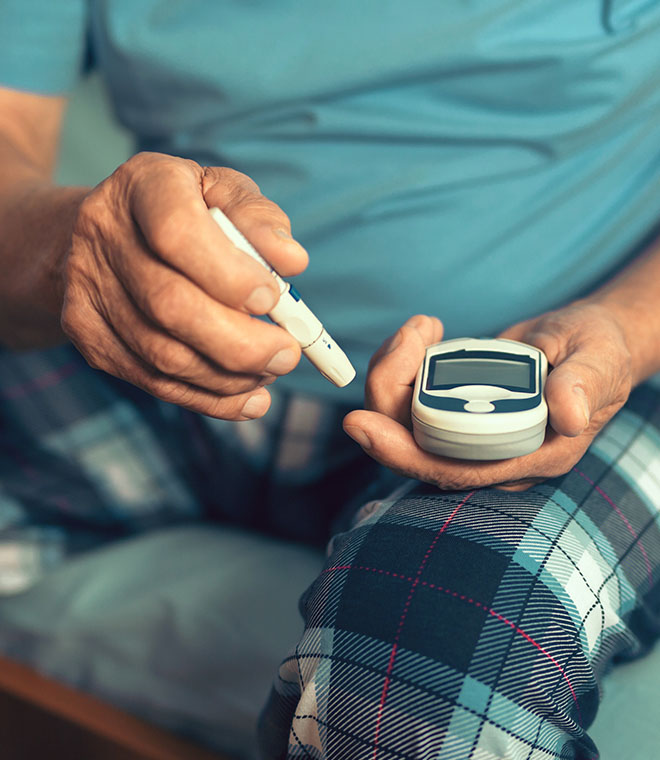Health
What is pre-diabetes?
Mar 15, 2021 • 5 min
What does pre-diabetic mean?
Prediabetes means that your blood sugar levels (also called glucose) are higher than normal, but not high enough to be called diabetes. An estimated 1 out of 3 American adults have prediabetes. According to the Centers for Disease Control and Prevention (CDC), 90% of people with prediabetes don’t know they have it. Prediabetes puts you at an increased risk of developing type 2 diabetes, heart disease and stroke.
Should I get my blood sugar tested?
It is important to talk to your healthcare provider about getting your blood sugar tested, especially if you have any of the following risk factors for prediabetes:
- Being overweight
- Being age 45 or older
- Having a parent or sibling with type 2 diabetes
- Being physically active less than 3 times a week
- Having a history of diabetes during pregnancy
- Birthing a baby weighing more than 9 pounds.
According to the CDC, African Americans, Hispanic/Latino Americans, American Indians, Pacific Islanders, and some Asian Americans are at higher risk for prediabetes.
What are the blood tests for prediabetes?
There are several blood tests for prediabetes and diabetes.
The glycated hemoglobin (A1C) test shows your average blood sugar level over the past two to three months. In general, an A1C level below 5.7% is considered normal.
The fasting blood sugar test involves testing a blood sample after you fast for at least eight hours or overnight. In general, a fasting blood sugar level of 99 mg/dL or lower is considered normal.
An oral glucose tolerance test measures how quickly your blood sugar returns to normal after fasting and then drinking a sweetened beverage containing 75 grams of glucose. Blood sugar levels are tested periodically for the next two hours after drinking the liquid. At two hours, a blood sugar level of 140 mg/dL or lower is generally considered normal.
The American Diabetes Association (ADA) recommends that diabetes screening for most adults begin at age 45. The ADA advises diabetes screening before age 45 if you're overweight and have additional risk factors for prediabetes or type 2 diabetes.
Can I determine my own risk for prediabetes?
You can take the risk test for prediabetes on the CDC’s website and share the results with your healthcare provider.
Can prediabetes be reversed?
Yes, prediabetes can often be reversed. Losing a small amount of weight if you are overweight can reverse prediabetes and lower your risk for developing type 2 diabetes. Modest weight loss is losing 5% to 7% of your body weight, or about 10 to 14 pounds for a 200-pound person. For example, to lose 12 pounds to improve your health means losing about 1 pound per week for 12 weeks.
If you have prediabetes, regular physical activity also lowers your risk for developing diabetes. This means getting at least 150 minutes a week of brisk walking or a similar activity. That’s 30 minutes a day, five days a week.
Eating healthy foods can also help bring your blood sugar level back to normal. A healthy diet means choosing nutrient-dense foods, like fruits, vegetables, whole grains, lean sources of protein and low-fat and nonfat dairy products, over foods high in saturated and trans fats, added sugars and sodium (salt).
Can prediabetes be prevented?
Yes, in many cases it’s possible to prevent prediabetes. The same lifestyle changes that can help reverse prediabetes might also help prevent prediabetes. Weight loss, increased physical activity, and following a healthy diet can help reduce your risk of prediabetes.
Clinically reviewed and updated by Amy Magill, MA, RDN, March 2021.
Sources:
1. https://www.cdc.gov/diabetes/basics/prediabetes.html
2. https://www.cdc.gov/diabetes/risktest/index.html
3. “Diabetes Prevention” https://www.cdc.gov/
4. https://www.cdc.gov/diabetes/prevention/people-at-risk.html
5. https://www.cdc.gov/diabetes/basics/getting-tested.html
6. https://www.mayoclinic.org/diseases-conditions/prediabetes/symptoms-causes/syc-20355278



